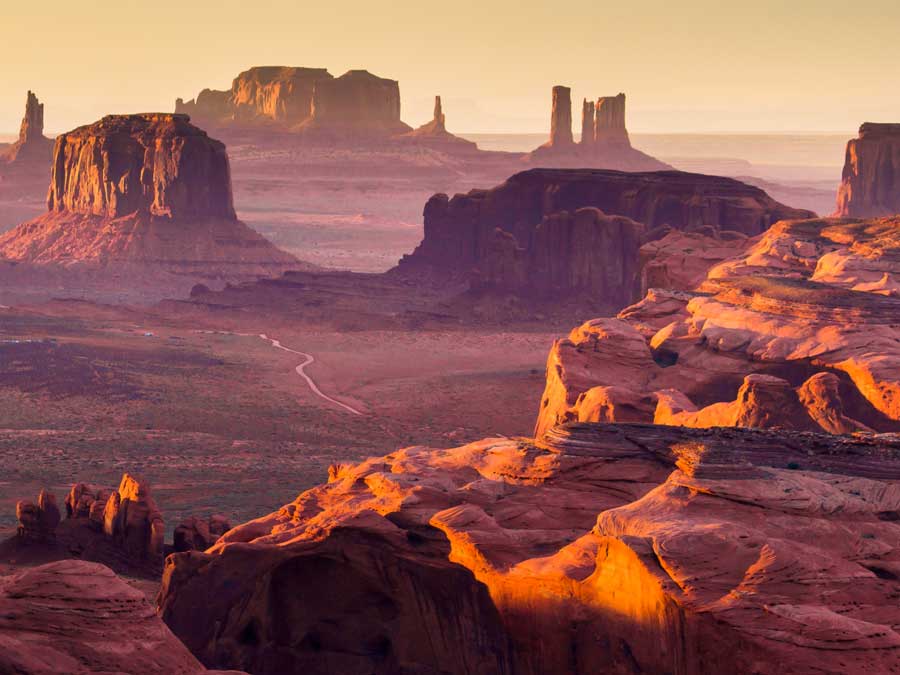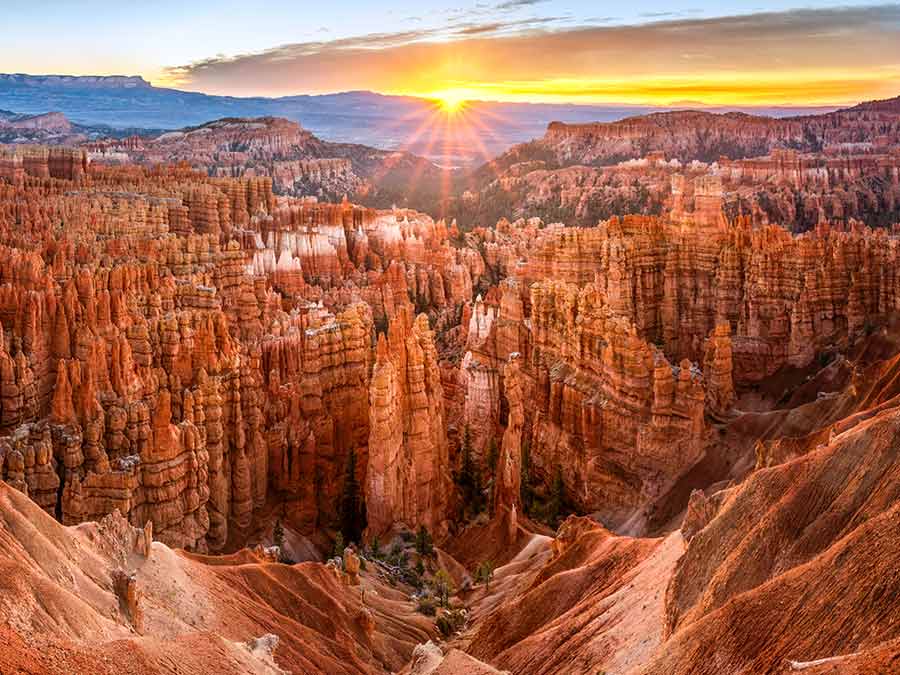
Travel insurance for the USA
Enjoy an unforgettable American adventure
From the glitz and glamour of Hollywood to the natural beauty of Yellowstone National Park, the USA is brimming with travel possibilities. With 50 states and spanning nine time zones, the staggering size of the country and the sheer number of bucket list attractions means that no American holiday ever feels long enough.
However, travelling to the United States can also pose a few risks, including costly medical care, travel disruptions, pickpocketing and violent crime.
Comprehensive travel insurance for the USA can provide cover for many of the most common risks that travellers to the USA may face. So, what should a comprehensive travel insurance policy cover, what should you know, and how can you stay safe on your American adventure?
Do Australians need travel insurance for the USA?
While the USA is one of the most popular international destinations for Aussie travellers, you may wish to better protect yourself with comprehensive travel insurance on your trip. Many have read horror stories of uninsured travellers being stung with medical bills, stranded due to natural disasters and suffering lost and stolen valuables in the USA.
At SCTI, we’re committed to giving Aussie travellers the confidence they need to enjoy their American holiday to the fullest.
What does a comprehensive travel insurance policy for the USA cover?
So what should your travel insurance policy for the USA include? Whether you’re hitting the beaches of Los Angeles or the streets of New York City, it’s important that your policy has a wide range of benefits with adequate cover limits. Let’s take a look at five must-haves for your USA .
1. Medical and hospital cover in the USA
Healthcare in the USA is generally of an excellent standard, but it’s also notoriously expensive. Hospitals have even been known to refuse treatment to uninsured travellers and demand large up-front deposits before providing medical care.
If you find yourself in a medical emergency in the USA, it’s a good idea to present your Certificate of Insurance to the hospital when you are admitted.
Our International Medical Only travel insurance policy is designed for the budget-conscious travellers and our International Comprehensive travel insurance policy provides cover for unlimited medical expenses and medical evacuation if required. Our policies include cover for:
- Medical treatment
- Doctors’ visits
- Prescribed medication
- Specialist treatment
- Medical transport costs
- Emergency dental treatment
- Cash allowance
- Accompanying person.
We understand how disruptive and upsetting a medical emergency can be on holiday, which is why we offer 24/7 emergency assistance and the support of qualified medical advisers. You can contact our team if you’ve been admitted to hospital and your medical expenses are likely to exceed $2,000 or if you’ve been told you need a medical flight upgrade. If you’re concerned about your health you can speak to our medical team for advice – but remember if you’re experiencing severe symptoms seek urgent medical advice or call the local ambulance service.
2. Rental vehicle excess
One of the best ways to explore the endless plains of the USA is by hitting the road. Cruising down the iconic Route 66 in a rental car is a true bucket-list adventure, but one that requires careful planning.
In some states, travellers can legally drive on an Australian full driver’s license in the USA for up to 12 months after their arrival. In others, an International Driving Permit is required. If, as a result of an unexpected event, the rental vehicle you have hired is stolen or damaged, you’re covered for rental vehicle excess of up to $10,000 under your travel insurance. If you’re planning on renting a car for a great American road trip, remember to:
- Obey local driving laws
- Hire your vehicle from a licensed rental agency
- Comply with the terms of the rental vehicle agreement
- Only drive on formed or paved roads
- Don’t drink and drive under any circumstances.
3. Cover for lost, stolen and damaged valuables
Losing your luggage can easily turn into a traveller’s nightmare, especially when passports and travel cards are involved. We know how frustrating and costly a travel mishap like this can be, which is why our travel insurance policy can provide cover for personal items that are lost, stolen or damaged as a result of an unexpected event.
Travellers to the USA, especially those visiting the bigger cities like New York City, Los Angeles, Boston and Chicago, should be on the lookout for pickpockets. Petty theft is common in America and unsuspecting tourists are the prime target. Take constant care of your possessions and be sure you never leave valuables unattended. Please note that our International Comprehensive travel insurance policy has terms and conditions around property and in what situations we provide cover.
4. Travel insurance for cancellations and delays in the USA
Whether it’s a connecting flight or an important event, cancellations and delays are another frustrating reality of travelling. Our International Comprehensive policy offers cover for changes to your journey before and after you leave to help minimise these disruptions to your journey.
If your trip to the USA is cancelled or changed due to an unexpected event before you leave Australia, our travel insurance can provide cover for cancellations fees and prepaid travel costs.
If the unexpected happens during your holiday, your policy offers cover for transport, accommodation, meals, activities and tour costs if you cannot reach your next destination on time, or if you need to cut your trip short and return to Australia.
5. Natural disaster cover
Yosemite’s towering peaks, Colorado’s winter slopes, challenging Hawaiian waves - the USA can be an adventure traveller’s playground. However, it’s not immune to a range of natural disasters, including hurricanes, floods, earthquakes, tornados and more.
Your USA travel insurance should include natural disaster cover in case your travel plans are thrown into disarray due to an unexpected natural event.
If your prepaid travel arrangements (such as flights, accommodation and excursions) need to be changed or cancelled because of an unexpected natural disaster in the USA and your insurance started before the event occurred, our International Comprehensive travel insurance policy can offer cover if you need to cancel or change the dates of your prepaid travel plans.
If you’re stuck overseas because your flight has been delayed or cancelled due to an unexpected event, we can offer cover for the cost of additional expenses, including scheduled transport and accommodation expenses incurred while you are waiting to return home. Please note that our International Comprehensive travel insurance policy has terms and conditions around additional expenses and which situations we provide cover for.
How to stay safe in the USA
The United States is a generally safe and welcoming country for Australians, however health and safety should be at the top of any traveller’s mind. As well as staying up-to-date with current travel warnings on the Smarttraveler website, visitors should keep a few things in mind when travelling to the USA.
Watch out for crime and pickpockets
Reports of pickpocketing in the USA have been rising in recent years, but many of the scams used by these thieves have stayed the same for decades. Take particular care of your valuables on crowded city streets, while riding on public transport and in congested areas like escalators.
Many modern-day pickpockets prefer to work in teams, using an accomplice to act as a distraction or “stall” while someone with sleight of hand fishes for your valuables before handing them to yet another team member for the getaway. As a rule of thumb, if somebody shows an unusual amount of interest in you or insists on grabbing your attention, stay wary of your surroundings.
Stay healthy
Good health habits are a great way to avoid upsetting medical disruptions to your holiday. Remember to practice safe eating when enjoying the USA’s famous food scene. This includes:
- Using your best street-food judgement
- Avoiding hot meals that have gone cold and cold meals that have gone warm
- Using extra care at communal eateries like buffets.
Practice safe adventure travel
Whether it’s hiking, climbing, skiing or surfing, you’ll find your flavour of adventure travel in the land of red, white and blue. Remember to pack carefully, stick to your limits, choose licensed tour operators and understand your insurance cover when enjoying the great outdoors.
Avoid political unrest
Unfortunately, the USA has seen numerous events of political and social turbulence in recent years, sometimes resulting in rioting and curfews. If your trip coincides with political unrest, obey government advice, stay up to date with the news and avoid any demonstrations.
Large gatherings can be unpredictable, and tensions can boil over quickly, turning even peaceful demonstrations into seriously dangerous environments.
Stay safe on the roads
Ask any Australian who has rented a car in the United States and they’ll all say that the first time driving on the right-hand side of the road can be a mind-bending exercise. If you’re planning a USA road trip, keep in mind that local driving laws, bustling eight-lane highways, converting kilometres to miles and driving on the right can add up to a real challenge of concentration.
Before your trip, consider watching a few dashcam driving trips in the USA on YouTube to get a feel for the flow of the road. This will help your mind to adapt once you get behind the wheel.
USA travel insurance exclusions
We’re proud to provide travellers with an award-winning comprehensive travel insurance option, but it’s important to remember that no travel insurance offers cover for everything. Your USA travel insurance may not include cover for things like:
Cover for pre-existing medical conditions (PECs)
Pre-existing medical conditions (PECs) aren’t automatically covered under our International Comprehensive travel insurance policy, but can be added as extras when buying your policy.
If you want cover for pre-existing medical conditions, there are a few definitions that you should be aware of, and you’ll need to complete our medical assessment to find out if we’ll offer you cover and the cost.
If you’re unsure about pre-existing conditions and how they may affect your policy, you can contact us to find out more – we know how important it is to be sure what you are and aren’t covered for when choosing your policy.
Non-medical evacuation and political unrest
Travel insurance doesn’t automatically cover the need for evacuation due to political unrest, so as mentioned above, be sure to check your Product Disclosure Statement and stay up to date with the news and reconsider your need for travel should your trip coincide with unrest.
Extreme sports and adventure activities
Some sports and activities aren’t always covered, even with a comprehensive policy. Read your policy documentation carefully to check that any activities you’re planning on partaking in are covered by your policy.
Embarking on an American adventure is an exciting experience, but it comes with its share of risks, including safety concerns and unexpected medical expenses. Travel insurance is essential for your next trip to the USA – whether you’re strolling the iconic streets of New York City or traversing the states by way of road trip, you’ll want to be sure you’re covered!
The content of this article is general and provided for information purposes only. Southern Cross Travel Insurance (SCTI) doesn’t guarantee or warrant the accuracy, completeness or currency of any article.
This article may contain hyperlinks to other websites owned or operated by third parties, or references to third party products or services. SCTI isn’t responsible for, and makes no recommendation about, the content or accuracy of any third party website, or for the suitability or performance of any product or service. The inclusion of a link in this article doesn’t imply that SCTI endorses the website or third party product/service.
What you need to know
This page includes some information about our products but, as with all insurance policies, eligibility criteria, terms and conditions apply. For our terms and conditions (including information about exclusions, excesses and sub limits) we recommend you read the relevant Financial Services Guide (FSG), Product Disclosure Statement (PDS) and Target Market Determination (TMD) to ensure our travel insurance products are right for you.
You can find the relevant documents here: International Comprehensive, Annual Multi-trip, International Medical Only, Working Overseas, Domestic.








